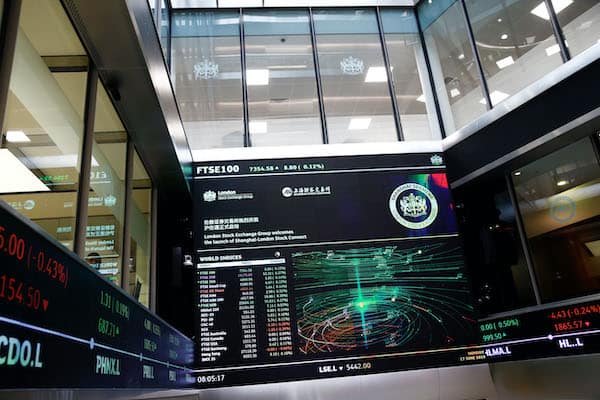Bussiness
The significant events in the global economy over the past week – London Business News | Londonlovesbusiness.com

The U.S. stock market displayed resilience last week, with large-cap stocks achieving a fourth consecutive weekly gain.
This occurred despite concerns over escalating tensions in the Middle East and a temporary dockworkers’ strike at major East and Gulf Coast seaports.
Rising oil prices, driven by the uncertainty in the Middle East, benefited energy stocks, while cruise lines and consumer discretionary sectors experienced declines. Notably, Nike shares fell sharply after the company retracted its full-year sales guidance.
Midweek, U.S. markets reacted to reports of potential retaliation by Iran, leading to significant volatility. Despite the initial sell-off after Iran launched missiles toward Israel, stock markets stabilized as worst-case scenarios failed to unfold.
Adding to market complexities, the International Longshoremen’s Association initiated a strike, potentially disrupting U.S. trade flows. However, fears of long-term supply chain disruptions eased as a temporary agreement postponed further walkouts until January.
On Friday, the Labor Department’s nonfarm payrolls report revealed a surprising addition of 254,000 jobs in September, nearly double analysts’ expectations. The unemployment rate fell to 4.1%, signaling continued strength in the labor market. However, wage growth of 0.4% added inflationary pressures, which tempered investor optimism. Manufacturing jobs continued to decline, with the sector reporting its fifth consecutive month of contraction, while the services sector remained robust, driven by strong consumer demand.
The upbeat jobs report led to a sharp rise in Treasury yields, with the 10-year U.S. Treasury note reaching its highest level in nearly two months. Meanwhile, the investment-grade corporate bond market saw strong demand, but high-yield bonds were under pressure due to the uncertain geopolitical environment. Overall, despite a volatile week, key U.S. indices ended with modest gains, highlighting the market’s ability to absorb multiple economic and geopolitical risks.
In Europe, stock markets closed lower as investors remained cautious about the ongoing Middle East conflict. The pan-European STOXX Europe 600 Index fell 1.80%, while major indexes in Italy, France, and Germany saw significant losses. The UK’s FTSE 100 Index, however, experienced only a slight decline, reflecting some resilience in the market.
Economic data added to the uncertainty, with Purchasing Managers’ Indexes (PMIs) indicating weaker growth across the eurozone. Inflation fell below the European Central Bank’s (ECB) 2% target in September, strengthening the case for a potential rate cut in October. Annual inflation dropped to 1.8%, the lowest level in over two years. Core inflation also eased slightly, but concerns remain about the region’s long-term economic stability.
ECB President Christine Lagarde hinted at the possibility of easing monetary policy, signaling that inflation could return to target levels sooner than expected. This dovish stance was echoed by other ECB officials, who suggested that interest rates might soon be lowered to support growth. In contrast, the Bank of England (BoE) presented a more mixed view. While Governor Andrew Bailey raised the prospect of future rate cuts, Chief Economist Huw Pill expressed caution, particularly regarding inflation in services and wage growth.
Overall, European markets are grappling with a combination of slowing growth, moderating inflation, and geopolitical risks, which continue to weigh on investor sentiment. The potential for rate cuts in the coming months, however, may provide some relief and help support economic activity across the region.
Japan’s stock markets experienced sharp declines at the start of the week, influenced by the election of Shigeru Ishiba as the new Prime Minister. His initial hawkish stance on monetary policy sent the yen higher and Japanese stocks lower. However, as Ishiba adopted a more dovish tone, markets recovered some of their losses. The Nikkei 225 Index and TOPIX Index still ended the week in negative territory, reflecting ongoing concerns about Japan’s economic outlook. Meanwhile, the yen weakened against the U.S. dollar, driven by rising U.S. Treasury yields.
Despite the political transition, Ishiba signaled continuity in Japan’s economic policies, emphasizing efforts to combat deflation and support regional economies. The new government is expected to implement stimulus measures aimed at alleviating inflationary pressures on households ahead of a snap election later this month. Bond yields in Japan followed U.S. trends, rising in response to stronger-than-expected U.S. economic data.
In China, stock markets surged during a shortened trading week, driven by optimism about Beijing’s support measures. The Shanghai Composite Index gained over 8%, while Hong Kong’s Hang Seng Index climbed more than 10%. Despite these gains, China’s economic data remained weak, with factory activity contracting for the fifth consecutive month. The country’s manufacturing PMI stayed below the growth threshold, signaling ongoing challenges in the industrial sector.
To counteract these economic headwinds, China’s largest cities have relaxed homebuying restrictions to stimulate demand. Guangzhou, Shanghai, and Shenzhen reduced down-payment ratios, reflecting the government’s broader efforts to stabilize the real estate market. While these measures provided a short-term boost to market sentiment, the longer-term outlook for China’s economy remains uncertain as it navigates its recovery from the recent slowdown.
In summary, global markets continue to face a mix of geopolitical tensions, economic slowdowns, and policy responses. While the U.S. remains resilient, Europe and Asia grapple with growth challenges and inflationary pressures. Investors are likely to remain cautious as they assess the impact of these factors in the weeks ahead.










